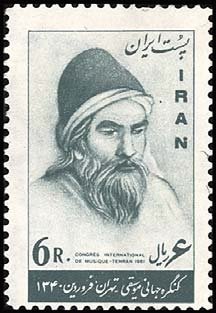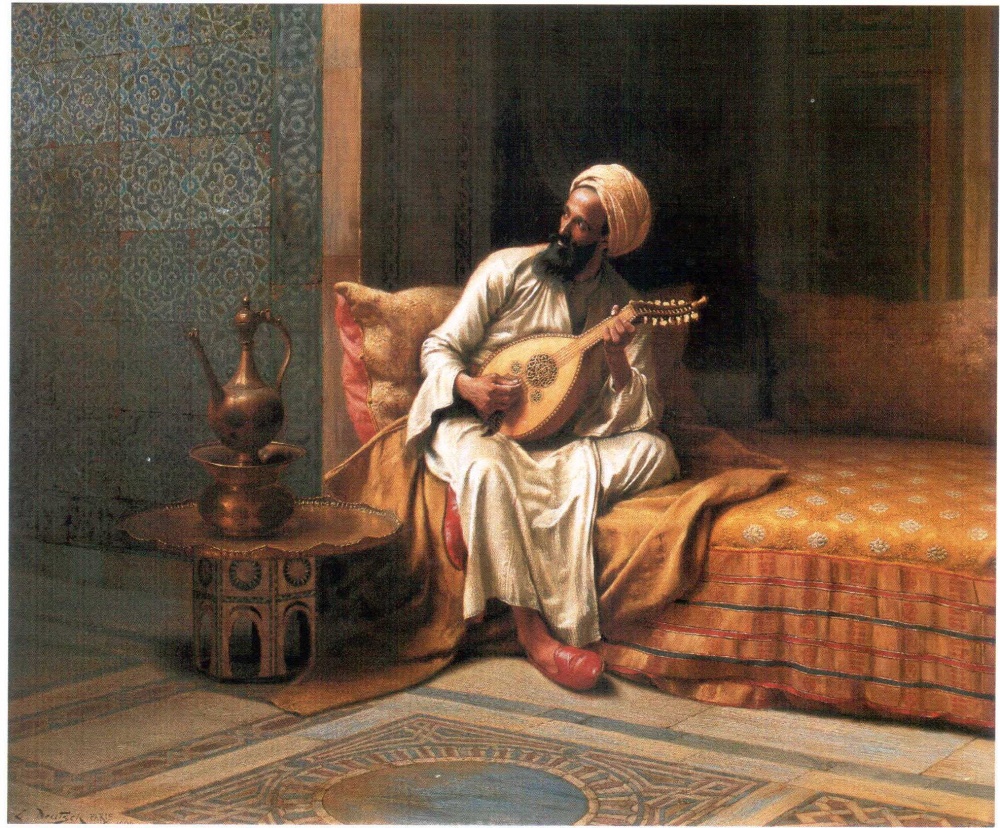[Al-Urmawi] was the greatest of music theorists. He was the pioneer of a school which propagated the "Systematist Theory"


***
Editor’s Note: The following is an extract from N.A Baloch’s ‘The Great Books of Islamic Civilisation’. This is a short summary of Al-Urmawi’s ‘Book of Musical Modes.’
***
  Figure 1. An Azerbaijani carpet depicting Al-Urmawi (Source) |
Safi al-Din Abu al-Mafakhir `Abd al-Mu`min b. Yusuf b. Fakhir al-Urmawi al-Baghdadi was born in Baghdad in the early years of the 6th/13th century. The family originally belonged to Urmia, a town in Adharbaijan. Safi al-Din received good education, and especially excelled in music, calligraphy and correspondence (insha’). Eventually he attained high positions as official scribe, librarian, and court minstrel and boon companion of Caliph Al-Musta`sim (1243-58 A.D.). He received a pension of 5,000 golden pieces a year. Safi al-Din was in Baghdad when it was sacked by Hulagu in 656/1258. When the city was given over to the Mongol holders for slaughter and pillage, his music reputation helped Safi al-Din and he gained access to Hulagu and ‘so charmed the conqueror by his performances on the Cid that Hulagu ordered that Safi al-Din, his family and property should be spared in general devastation’. Hulagu took him into service and his pension was doubled to 10,000 pieces of gold, which was paid out of the revenues of Baghdad. He then became tutor to the sons of the wazir Shams al-Din Muhammad b. Muhammad al-Juwayni, who with his brother ‘Ata Malik, the author of the Tail kh-i Jahan Gusha’ , appointed the famous musician to head the Correspondence Bureau (Diwan-i Insha) in Baghdad.
Safi al-Din’s two pupils, Baha’ al-Din Muhammad and Sharaf al-Din Harun, the sons of the wazir were extremely kind to him. Baha al-Din on being appointed as governor took Safi al-Din with himself to Isfahan in 1265 A.D. On the death of Baha’ al-Din (1279) and the fall of the family of Al-Juwayni (1284), the great musician fell on evil days, was imprisoned for a debt of 300 pieces of gold and died in a debtor’s prison in 693 A.H. (1284).
For his great skill in music, he was excelled by none since the days of Ishaq al-Mausili, the boon companion of Harun al- Rashid. He was the inventor of two stringed instruments, the mughni (an arch-lute) and the nuzha (a new type of psaltery).


Figure 2. A manuscript copy of Risalah al-Sharafiyah fi al-Nisab al-Ta’lifiyyah, one of al-Urmawi’s 2 famous works, 16th century, Adilnor Collection (Source)
After Farabi, Safi al-Din was the greatest of music theorists. He was the pioneer of a school which propagated the “Systematist Theory”. Sag al-Din authored two important works on the theory of music – Kitab al-Adwar (Book of Musical Modes) and al-Risalat al-Sharafiyya (The Sharafiya Treatise). Both were used as text books, and remained authority among music theorists for centuries.
Kitab al Adwar, better known to the theorists, was probably written in 1252 A.D. It is divided into fifteen sections (fusul) dealing with.
1. the notes (anghln),
2. the frets (dasain),
  Figure 3. Iranian stamp depicting Al-Urmawi (Source) |
3. the lute (`ud),
4. the intervals (ab’al),
5. the composition (tan.),
6. the modes (adw.ir),
7. the two stringted pandores,
8. the lute of five strings,
9. the popular modes (adwar),
10. the related notes ,
11. the scales (tabaqit),
12. the accordatur (istihab),
13. the rhythm,
14. the influence (ta’thir) of notes (tanabir),
15. the performance.


Figure 4. Al-Urmawi’s Risalah al Sharafiyyah fi Nisab al-ta’lifiyyah; Treatise on Music (Source)
The other book al-Risalat al-Sharafiya fa al-Nisab al-TaTifiya (The Sharafiya Treatise on Musical Conformities in Compostion) was written by about 666/1267 and dedicated to the Wazir’s son Sharaf al-Din Harun (d. 678/1279). The book is divided into five Discourses (maqalat) with the usual sections (fusul). These deal with the bases of sound (saut), intervals (ab`ad), as well as the six ‘finger scales’ (mawajib). According to Farmer, it is a more finished work than ‘The Adwar’.


Figure 5. Ludwig Deutsch – The Mandolin Player (Source)
Regarding Safi al-Din’s stature as a music theorist, Farmer has observed that in the East, Safi al-Din was ‘looked upon as fountain head in the subject, whilst the European West has penned fulsome praise of his abilities. Kiesewetter called him ‘the Zarlino of the Orient’, Sir Hubert Parry considered the Systematist Scale to be ‘the most perfect ever devised’, for, as Riemann says, it gives consonances purer than our scale can afford us. Even Helmholtz considered that the theory of Safi al-Din was ‘noteworthy in the history of the development of music’.
4.7 / 5. Votes 169
No votes so far! Be the first to rate this post.




Muslim Heritage:
Send us your e-mail address to be informed about our work.
This Website MuslimHeritage.com is owned by FSTC Ltd and managed by the Foundation for Science, Technology and Civilisation, UK (FSTCUK), a British charity number 1158509.
© Copyright FSTC Ltd 2002-2020. All Rights Reserved.
